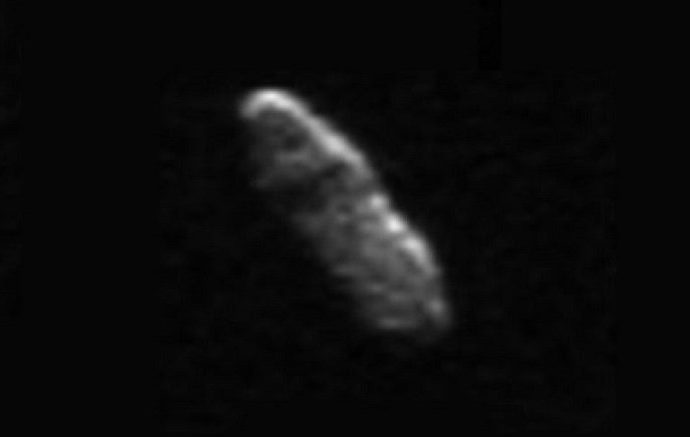A potentially hazardous asteroid (PHA), designated 2003 SD220 (or 163899), is expected to fly by the Earth on Saturday, December 22, at around 1:04 UTC.
The space rock, estimated to be about a mile wide (1.6 kilometers), will pass by our planet at a distance of approximately 7.34 lunar distances (LD), what corresponds to 1.75 million miles (2.81 million kilometers).
2003 SD220 is an Aten-type asteroid discovered on September 29, 2003, by astronomers of the Lowell Observatory Near-Earth-Object Search (LONEOS) at Anderson Mesa Station near Flagstaff, Arizona. LONEOS was a project designed to discover asteroids and comets, which ran from 1993 to 2008.
2003 SD220 has an absolute magnitude of 17.3 and orbits the sun every 275 days at a distance of about 0.82 AU (76.2 million miles, or 122.6 million kilometers). Observations conducted with Goldstone Solar System Radar (GSSR) and Arecibo Observatory during the asteroid’s previous close approach to Earth almost exactly three years ago, show that it has an elongated shape and is a slow rotator—having a long rotation period some 285 hours.
“We don’t know the asteroid’s exact size, but the initial radar measurements indicate that it is an elongated object. Its length is well over 1 kilometer, roughly between 1.5 and 2 kilometers, while the shorter axis is roughly 1 kilometer,” Paul Chodas, Manager of Jet Propulsion Laboratory’s Center for Near Earth Object Studies (CNEOS) told Astrowatch.net.
“The diameter estimate is based on a brightness measurement in the telescope. To get the diameter from that we would really need to know how much light it reflects. This depends on the material properties—which we don’t know, but can estimate. From that I would say that it is between 1 and 2 kilometers,” said Detlef Koschny, head of the Near-Earth Object (NEO) Segment in the Space Situational Awareness (SSA) program office at European Space Agency (ESA).
During the December 22 fly-by, 2003 SD220 will pass by the Earth with a relative velocity of 6.2 km/s. Although this object is listed as a PHA, astronomers rule out the possibility that it could hit our planet.
“We know the trajectory of this asteroid extremely well, and we know that it poses no hazard of impacting Earth during its fly-by this week, or anytime in the next hundred years. We will know its orbit even better after all the observations during this fly-by, and we should be able to rule out any impact for many centuries into the future,” Chodas said.
“The object is not in our ‘risk list’, what means that there is zero chance that it could hit the Earth,” Koschny told Astrowatch.net.
Since November 24, 2018, the Goldstone radar is once again observing 2003 SD220 and will be closely monitoring it when it passes by our planet on Saturday. The object is also on the list of observational targets for Arecibo and other ground-based facilities like the Very Long Baseline Array (VLBA). All in all, astronomers hope that the new observational campaign during the asteroid’s upcoming close approach, could provide essential insights into physical characteristics of this space rock.
“It is already being observed by Goldstone and several other radar facilities. We should get some excellent images of the asteroid that will at least reveal its size and shape and possibly even surface features like craters and boulders. This is an extremely slow rotator, however, which blurs some of the features in the Doppler direction, so it’s hard to predict exactly how clear the radar images will be,” Chodas noted.
Next close approach of 2003 SD220 to Earth is expected on December 17, 2021. On that day, it will miss our planet at a distance of approximately 14.6 LD (3.5 million miles, or 5.6 million kilometers).
On December 19, there were nearly 2,000 PHAs detected, however none of them is on a collision course with our planet. PHAs are asteroids larger than 100 meters that can come closer to Earth than 19.5 LD (4.65 million miles; 7.5 million kilometers).
To date, astronomers have discovered more than 19,300 NEOs. Only this month, 93 such objects have been detected.
Source: Phys.org

































Leave a Comment
You must be logged in to post a comment.